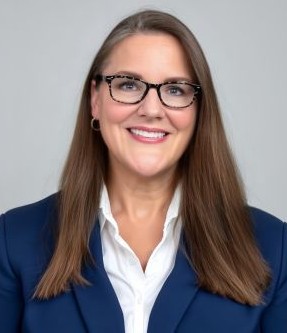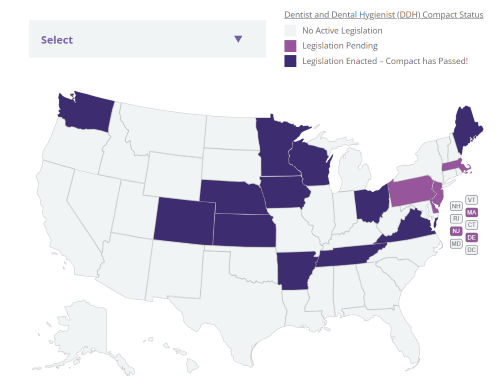Enter your email to receive the CareQuest newsletter:
November 3, 2025
By Bronwyn Barrera, MBA, Director of Marketing & Communications, ADHA and Kelly Schroeder, MS, RDH, Program Evaluation Specialist, CareQuest Institute
For years, dental hygienists have been frustrated with having to hunt through multiple websites and sources to piece together information about continuing education requirements and scope of practice variations. This is even more challenging for dental hygienists who are licensed in — or want to practice in — more than one state.

As more states sign onto the interstate licensure compact, making it easier to work in multiple states, the issue of knowing legislative requirements for each state continues to escalate.

The solution to this growing problem seemed straightforward: Consolidate as much available information into one centralized, visual platform. That’s why the American Dental Hygienists’ Association (ADHA), with grant funding from CareQuest Institute, created two interactive maps — one focused on initial licensure requirements, and the other covering licensure renewal requirements.
- The Initial Licensure Map has information about each state’s accepted clinical exams, scope of practice overview, and state rules and regulations.
- The RDH License Renewal Map has information about each state’s renewal cycle, CE hours required per cycle, renewal fees, special requirements, and scope of practice overview.
Individual states in both maps are color coded for their dentist and dental hygienist legislative compact status. (A state with no active legislation to sign onto the licensure compact is gray, pending legislation is purple, and enacted legislation is indigo.)
Since launching in late July 2025, the interactive licensure maps have attracted more than 5,000 visitors. While these numbers show interest, we wanted to know: Would dental hygienists actually use this resource? And would it make their professional lives easier?
How Dental Hygienists Are Using the Maps

To find out if the maps were serving their intended purposes, the ADHA did a pulse check survey of dental hygienists and educators across the country. The survey showed that dental hygienists are:
- Understanding scope of practice differences: Survey respondents use the maps to compare how the dental hygiene scope of practice allowances varies from state to state. This is important for anyone thinking about relocating or working across state lines.
- Managing license renewals: Some of the survey respondents said they use the maps to keep track of their continuing education requirements and renewal cycles, especially those juggling licenses in multiple states.
- Career planning: Dental hygienists are using the maps to make career decisions such as where to get their initial license and what other states they want to work in.
Here are some other highlights from the survey:
- Lauren Bouras, BSDH, RDH, in California, who is licensed in both California and Wisconsin, described the maps as having an “easy-to-navigate, centralized location” for critical information.
- Robin Marino, RDH, in Arizona encapsulated the ADHA maps in a single phrase — “ease of use and accuracy of information.”
- Another dental hygienist, who preferred to remain anonymous, shared how the maps helped with career strategy: “Knowing which states have signed legislation or have a bill introduced (around a specific scope of practice issue), and thinking about where [my] family is located if the need arises to relocate, or know[ing] where the potential to work part-time in retirement is when that day comes.”
A Help for Dental Hygiene Educators, Too
The majority of dental hygiene educators who participated in the survey were already aware of the maps and use them as a career building tool with their students.
Educators are incorporating the maps into their teaching in different ways:
- Classroom instruction: Dental hygiene educators are using the maps during lectures, particularly when discussing scope of practice and public health.
- Career counseling: The maps help students make decisions about which clinical board exams to take based on where they plan to practice.
- Advocacy education: Some instructors use the maps to help students connect policy to clinical practice, engage in advocacy work, and understand how legislative differences affect access to care.
This is what dental hygiene instructors had to say:
“It is an easy and concise resource for students to use,” one dental hygiene educator noted. “A one-stop shop, and they are exploring their options.”
Another educator said, “The maps are very useful in Dental Public Health [curriculum] when scope of practice is discussed.”
ADHA plans to update the maps semi-annually and will make changes sooner if needed. Future additions are being considered based on feedback from users, such as the number of dental hygiene programs per state.
The success of these maps shows how important it is to invest in tools that support the oral health workforce. Making licensure requirements easy to understand helps dental hygienists to manage their license and navigate their career options.
Editor’s Note: If you haven’t explored ADHA’s interactive licensure maps yet, visit adha.org/licensuremaps.